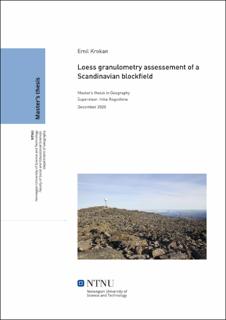| dc.contributor.advisor | Rogozhina, Irina | |
| dc.contributor.advisor | Peter, Maria | |
| dc.contributor.author | Krokan, Emil | |
| dc.date.accessioned | 2021-09-28T17:55:15Z | |
| dc.date.available | 2021-09-28T17:55:15Z | |
| dc.date.issued | 2020 | |
| dc.identifier | no.ntnu:inspera:66376427:5890428 | |
| dc.identifier.uri | https://hdl.handle.net/11250/2785205 | |
| dc.description.abstract | Blokkmarka i Sør-Norge er et omdiskutert tema i den grad de var under isdekket eller var plassert på nunataker i løpet av den siste istid. Løss-avsetninger kan tilby verdifull informasjon angående paleoklimatiske forhold, samt utbredelsen og tidspunkt for istider.
Den autoktone blokkmarka lokalisert på platået av gabbrofjellet Tron, sør-øst sentrale Norge utgjør grunnlaget for denne studien. To utgravde groper resulterte i åtte innsamlede horisonter av kolonner som strekker seg ned til en dybde på 1m. Løss-fraksjonene (2-63 µm) ble analysert med det sveipeelektronmikroskop (SEM) baserte automatisk mineralogi system (AMS). Analysemodusene Spot Centroid og mineral mapping ble benyttet som en sammenlignbar tilnærming og gjensidig validering av resultatene. Granulometrien og mineralogien ble eksaminert for å undersøke om denne tilnærmingen er tilstrekkelig til å skille løss fra ikke-løss. Mineralogien impliserer at det er betydelige mengder av kvarts silt tilstede i sedimentene, og at kornformene i hovedsak er klumpete og kantete til mindre kantete. Både mineralogien og kornmorfologien har likhetstrekk med løss-partikler på Loess Plateau i Kina, men metoden er ikke tilstrekkelig i seg selv til å skille vindblåst silt fra in situ-forvitret silt. | |
| dc.description.abstract | Blockfields in southern Norway are a highly debated topic concerning if they were glaciated or protruded as nunataks during the last glaciation. Loess deposits may provide valuable information concerning paleoclimatic conditions, and the extent and timing of glaciations.
The autochthonous blockfield situated on the summit of Tron gabbro massif, south-east central Norway makes the case for this study. Two excavated pits resulted in eight sampled horizons of columns reaching 1m depth. The loess-sized fractions (2-63 µm) were analyzed with the Scanning Electron Microscope (SEM) based Automated Mineralogy System (AMS). The two analysis modes Spot Centroid and mineral mapping were utilized in a comparable approach and mutual validation of the results. The granulometry and mineralogy were examined in order to investigate if this approach is sufficient to distinguish loess from in-situ weathered silt. The mineralogy implies that considerably amounts of quartz silt are present in the sediment composition, and the particle morphology is majorly bulky and angular to subangular. Both the mineralogy and grain morphology have similar features as the loess particles on the Loess Plateau in China, but the method is not substantial enough to separate aeolian from in-situ weathered silt. | |
| dc.language | | |
| dc.publisher | NTNU | |
| dc.title | Loess granulometry assessement of a Scandinavian blockfield | |
| dc.type | Master thesis | |
